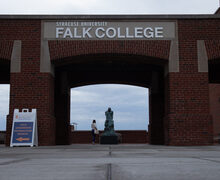Safe and sound: Two research teams receive funding to study how people communicate storm warnings
Natalie Riess | Art Director
A year and a half after Superstorm Sandy hit the East Coast, a grant will fund research to examine how storm warnings are perceived by residents who need to evacuate.
Two teams of researchers — each with a SUNY-ESF professor on board — recently received $150,000 from NOAA Sea Grant Coastal Storm Awareness Program to look at strategies to improve communication between storm officials and residents.
Laura Rickard, an environmental studies professor at the State University of New York College of Environmental Science and Forestry, is working with Cliff Scherer, a professor in the communications department at Cornell University, and Gina Eosco, a Ph.D. candidate at Cornell, to study how the threat of storms is communicated to others.
The grant money will go partly to creating experimental hurricane media broadcasts that will test a new storm surge map among a suite of hurricane graphics and information, Eosco said.
It will also pay students working on the project for travel expenses and setting up focus groups and surveys, Scherer said.
The team is currently analyzing how the risks are visualized and whether or not people understand what they are seeing. Focus groups were created in the risk areas, where volunteers then watch weather forecasts and then the team gauges their reactions.
Scherer said they know that photos of a risk tend to increase the perception that there is a hazard. However, much of the hazard is viewed through maps and radars, which doesn’t necessarily tell the public that the storm exists, he said.
Scherer was a weather forecaster many years ago and said his interest in the area stems from the idea of communicating risk. His goal is to get people to react to storms in a more efficient way, he said.
People tend to have “unrealistic optimism” when storms approach, Scherer said. He added that when people are told they need to evacuate, they often say, “it won’t happen to me.”
“There are hundreds of television channels that people are paying attention to,” he said. “How do we get the information that we need to to those people?”
Scherer said that sometimes even if people hear the warnings, they don’t understand what they mean and don’t believe the warnings.
Eosco, the Ph.D. candidate, said the forecast isn’t complete until it’s communicated, processed, understood and acted upon. She added that storm surges are the deadliest and most dangerous aspect of a hurricane and residents who live directly on the coast or near the coast are the most at risk.
“It is our intent to understand how the information in hurricane media broadcasts is helping individuals assess their risk and make evacuation decisions,” Eosco said.
The team plans to make recommendations for how the broadcast meteorology community communicates hurricane information in the future, specifically about storm surge risks, she said.
Sharon Moran, an environmental studies professor at ESF, is working on a separate storm warning project, together with co-principal investigator Bill Peace, a visiting professor of the Syracuse University Honors Program, Rebecca Garden, an associate professor at Upstate Medical School, and Sam Ratick, a professor at Clark University.
The project, titled “Understanding Responses to Storm Warnings: Learning From Those Who ‘Rode Out’ Hurricane Sandy,” seeks to learn from those individuals who wouldn’t or couldn’t evacuate as the storm loomed. Moran is working to develop hurricane forecasts that use a new storm surge inundation map.
She said she believes that a lot of places in society have a disconnection.
“People get advice or information but may not opt to heed it — that’s sometimes the case with storm warnings,” Moran said.
She said she developed the project after learning that, of the 300 people who were killed in Hurricane Sandy, most of them were older or had disabilities. She began studying who those people trusted, their perceptions and what their options really were, in order to learn more about the decision to evacuate or stay through the storm.
Said Moran: “There are opportunities to avoid loss of life in the future. We can do a better job, we just need to connect the information and the ideas of the emergency managers and the listeners in the right way.”
Published on February 24, 2014 at 12:49 am




